The Brief – “Be Patient”
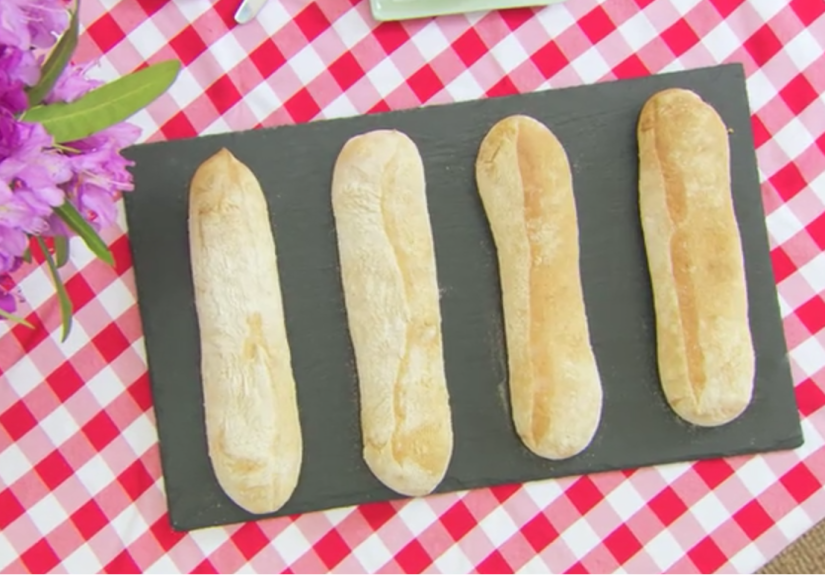
Series 5 (American Season 1), Episode 3. Before the sacred and ceremonial dismissing of the judges, Mel calls upon Mr. Hollywood as the “voice of bread” to give the humble bakers some words of advice and encouragement before their bread week Technical Bake. He gets an uncharacteristically blank expression and in a flat voice says, “Be patient.” Seems innocuous enough, but these words would come to plague the bakers, inducing paranoia and bouts of madness, as they rend their aprons and cry to the heavens, “How patient?”
After dropping that ticking time bomb, Paul “Watch the Bread Burn” Hollywood and his accomplice, Mary “Yeast Side Tilly” Berry, leave the tent so Sue can deliver the brief. The bakers have three hours to make four ciabatta loaves, with crisp, floury surfaces, and large, visible air holes on the inside. I’m going to give myself three hours and nine minutes to compensate for my conventional, non-fan oven. (For details, read the “WTFan??!!” section of my Merry Berry Cherry Cake article.)
This is my first Paul Hollywood bake, but I’m not going to let him intimidate me. I know Paul Hollywood, “The Mahogany Tiger” as Sue calls him, is known for taking bakers out at the knees upon hearing their paltry bake plans, and during bread week he is at his peak pomposity. In this very episode during the Signature Bake, he emasculates Richard entirely for uttering the words “American pumpernickel.” “There is only one pumpernickel and that comes from Germany” – a swipe of his claws and Richard is half as tall, blood and treacle everywhere. I have nothing to be afraid of, however, because he laid all of his methods for an impeccable ciabatta out in the Great British Baking Show: Master Class, S1:E2, from which I pulled this recipe and Paul Hollywood lives in the TV where his cutting comments can’t deflate my fragile ego.

The Shopping List
- A stand mixer. Yes, I knew I was going to end up getting a KitchenAid stand mixer for this project, but I had no idea it would be so soon. Frankly, I’m thrilled. I’ve always wanted one, but being only an occasional home-baker with limited counter space, it seemed like a tremendous luxury. But I’ve been baking more regularly and I have made a sacred vow to the blogesphere to complete all of the #GBBO techinical bakes, and ciabatta is practically impossible to make without one. And, plus, it comes in so many pretty colors! I got this beauty, a KitchenAid Artisan Series, from Amazon and then just sat by the door like an eager puppy until she arrived.
 And arrive she did in gleaming Aqua Sky! I’ve decided to name her Kimberley after my series Series 4 (Season 2) fave. She has clearly been socialized to be a bubbly, happy person, but a few bakes in it was plain to see she had the cool, calculating heart of a serious competitor. She introduced into my vocabulary the Japanese philosophy of ‘kaizen,’ which is the idea that one should always be striving to be better, and that idea of endless dissatisfaction really resonated with me. I’m smiling through the tears, too, Kimberley. Perfectionists unite!
And arrive she did in gleaming Aqua Sky! I’ve decided to name her Kimberley after my series Series 4 (Season 2) fave. She has clearly been socialized to be a bubbly, happy person, but a few bakes in it was plain to see she had the cool, calculating heart of a serious competitor. She introduced into my vocabulary the Japanese philosophy of ‘kaizen,’ which is the idea that one should always be striving to be better, and that idea of endless dissatisfaction really resonated with me. I’m smiling through the tears, too, Kimberley. Perfectionists unite!
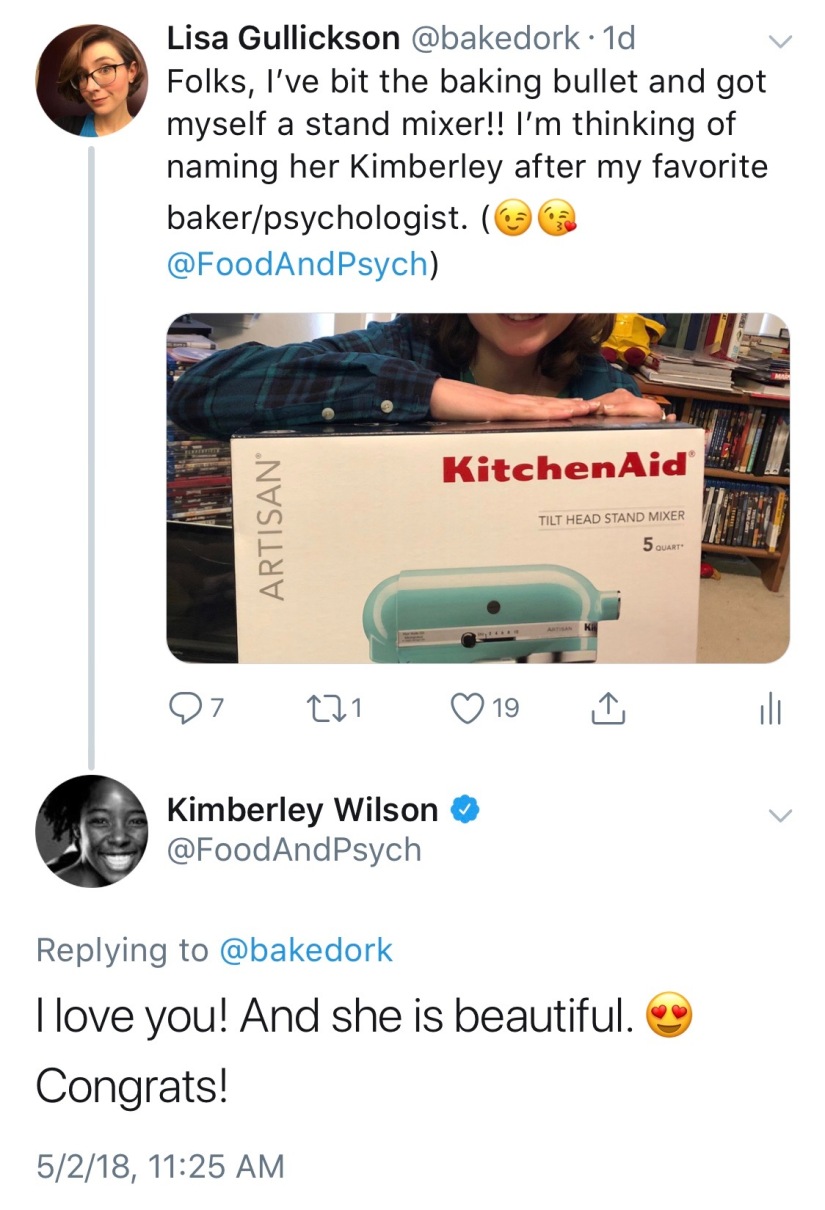
- A 3 Litre plastic box. To prove ciabatta and to have the dough dump out in the proper shape, you need a 3-liter plastic box, preferably with a lid. A litre is slightly less than a quart, so I ended up getting this 3-quart container but I wish I had gone with something more like that. The squarer the better, it turns out. Boo! Why did you not show me that the first time, internet!!
- A dough scraper. Now that I have this, I’m like, why aren’t all knives shaped like this?
- Strong Flour. I was able to find this at the grocery store, once I realized that it is just “bread flour.” Bread flour differs from all-purpose because of a higher protein content, which means there is more gluten so things get stretchier, and the more stretchier the more breadier, and the more goodier. That’s science.
On Your Marks, Get Set… Bake!

Timing is everything. Back in the judge’s tent, Paul unwraps the mystery behind his enigmatic advice for Mary Berry. The crux of a successful ciabatta is the prove. “Take this dough too early, and the air-holes will be very small, take it too late and they’ll go flat as a pancake.” When Paul Hollywood cuts the bread, he points out the different sized air pockets in the bread saying that the “irregular structure” is a sign of a descent ciabatta.
I knew with my three-hour-and-nine-minute bake time and a lot to prove (Har har!), I would want to maximize the time I had to prove the dough to foster those irregularly sized bubbles, so I did something a bit out of character – I planned ahead. Before starting my timer, I made myself a timetable factoring the rest time and bake time so I would have the longest prove possible. What I came up with was this:
TIMETABLE (189 minutes)
25 Minutes for Assembling Dough
149 Minutes for proving
10 Minutes for cutting
20 Minutes for resting
35 Minutes for Baking
That would give me just 2 hours and 29 minutes for proving. I just prayed to the gods of bread – Sara Lee, Wonder Man, and the knight on the Roman Meal bag – that it would be enough.

Don’t offend the yeast. If I’ve learned anything from watching GBBO, it’s that yeast is a temperamental diva. If you don’t serve her needs or upstage her in any way, she will not show up and do her job. Sweeteners, fillings, temperature, a sidelong glance, all can cause her to flip out and sabotage your bake and you end up with flat, unspectacular bread. That is why, in the Masterclass episode, Master Hollywood recommends keeping the yeast and salt on opposite sides of your mixer bowl. Salt can retard your yeast, so you want to keep them separate for as long as possible so that yeast can feel like the star that she is. I measured my flour into my mixing bowl and put the yeast on one side and the salt on the other, and clicked that bowl into the hot-seat, and I’m ready to get Kimberley’s motor running! That sounds dirty. Lock and load!
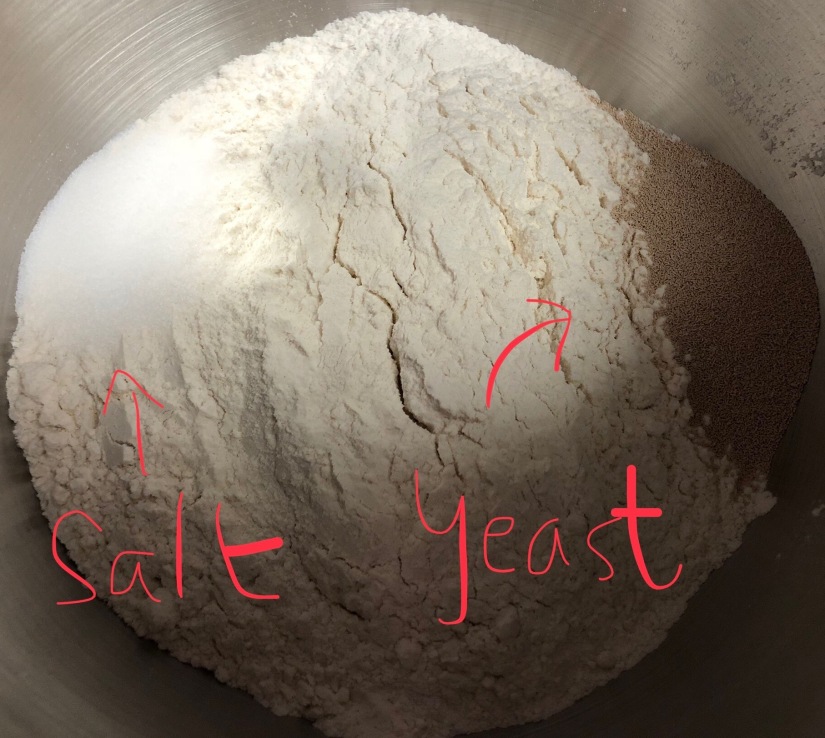
In the splash zone. “I know it’s supposed to be quite a wet dough, beyond that I am all at sea.” You and I both, Richard, you and I both. I add three-quarters of the water all at once as Paul Hollywood instructed, though while he eyeballed it, I measured out 330 mL of water because I am a literalist. He also specified not to use warm water, because warm water would speed up the rise too much and result in flavorless bread. He didn’t mention anything about cold water, but I’m sure it gives your yeast ennui or something, so I set out my water earlier that morning so I could get exactly room temperature water.
I turned the mixer up to a medium-low speed and the dough hook immediately started forming the flour and water mixture into a dough ball. I then turned up the mixer to medium and added the last quarter (110 mL) of water, which turned out to be the exact opposite of what I was supposed to because Kimberley immediately splashed floury water back in my face. Gotcha, Kimberley, water first, then turn up to medium.

Whiplash. Once you add the water, your dough starts slapping a mad beat on the side of the bowl. You go, daddy-dough! In the Masterclass, Paul Hollywood said the dough would go to the dough-ball, to the slap, and then back into a ball and the whole thing could take about 15 minutes. I set a 15-minute timer when I started the mixer, but the dough just kept slapping. I would stop it to check it with Martha’s “sticky trail” method, sticking the spatula in the dough and bringing it straight out to see if it falls in sheets, which kind of worked, but I was really looking for the dough to get ball-like again. After the 15 minutes was up, I did notice that the dough, which was still cookin’ a mad percussion solo, did stop leaving dough stuck to the metal bowl and was also picking up the glob of dough on the bottom of the bowl, so I assumed that was dough ball enough.
“Positively elastic!” exclaims Mary Berry, her eyes twinkling with delight. I love how, even as a glorious octogenarian, Ms. Barry can still be gob-smacked by bread. Adorable. When I stopped my dough hook, I was a pretty delighted myself. The dough was indeed stretchy just like the T.V. showed me, and it just made the whole process seem very promising.
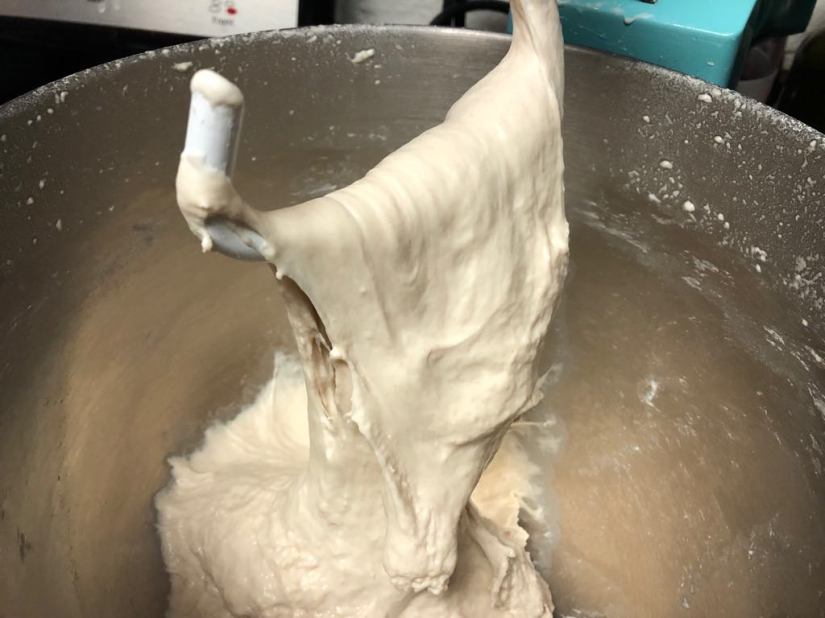
I then lubed up my three-quart box with olive oil, which is the most filthy thing I’ve ever said. Then it was a matter of getting the sticky, sproingy dough out of the metal bowl into the box. Mr. Hollywood suggests picking up the bread with your olive oily hands, which I did, but the dough insisted on clinging to the bottom of the bowl. Commence the Chaplain routine, but with way more audible swearing. I would lift the dough, and then the dough would lift the bowl. I would try to hold the bowl down with one hand, but then the dough would just stretch and still not let go of the bowl. I don’t know about you, but underneath my adorable, friendly exterior is just red-hot rage magma. I snapped at my poor husband to hold the infernal bowl so I could loosen the bastard dough before I chucked the whole thing out the window. My poor husband, when I am baking he has to be my Mel and my Sue – he’s my extra hands and my sense of perspective. Luckily, he doesn’t have to make the innuendo-laden baking puns, I’ve got that covered. Check out the beginning of the paragraph (So filthy. The BBC would never go for that.).

You think you can make ciabatta? Prove it. It blows my mind that some of the bakers put their boxes in the proving drawers of their oven, despite the sparse recipe specifying that they are to prove the dough at room temperature. The arrogance of it! The recipe was written and edited by Paul Hollywood himself, the B.B.C. took the time to laminate it, it is there to be followed, and yet Martha, Iain and Nancy all put their precious dough into the proving drawers. Sue’s ominous narration forebodes that their loaves will not hold their shape, and so it came to pass.
Granted, they’re in a tent in the middle of Welford Park in Berkshire where it goes from sunshine to full on raining from one moment to the next. They are less subject to room temperature than they are to a fluctuating and fickle tent temperature. Richard, who is a fairly reliable and skilled baker, buckles under the pressure and moves his dough to the proving drawer when the air starts to chill. Kate proves to be the stalwart, sticking to her guns and refusing put her bread-baby in the proving drawer corner.
The crux. I’m not one to watch sports, but I submit there is not a more thrilling minute of television than 10 British bakers waiting for bread to prove. Mel starts stirring the pot, asking Luis and Diane “Who is going to be the first to start doing something, though?” They’re all shuffling their feet and spying on each other when Kate’s hour timer goes off. They all start prepping their boards, flouring their surfaces and getting their baking sheets covered, as they sweat bullets, but it is Jordan, sweet Jordan, who finally cracks. He tips his dough out as Sue observes over his shoulder, “it’s like something out of a John Carpenter film!” Sadly for Jordan, bless his heart, this challenge ends about as happy as a John Carpenter film for him. But he’s not Kurt Russell.

I’m sure if I was trapped in a tent with just me and my swelling dough, I’d be tempted to poke at it a bit. Lucky for me, I’m in the comfort of my own home with my two loves – Brad and our endless Blu-ray collect. We spent the proving time watching Stephen Spielberg’s spin on a literary classic, Hook, about Peter Banning (Robin Williams) whose children are kidnapped by the infamous Captain Hook (Dustin Hoffman). Tinkerbell (Julia Roberts) fetches the bloated lawyer to fly him back to Neverland so she and the Lost Boys can unlock his memory so he realizes he is the real Peter Pan all grown up in time to save his kids. This movie is one of my childhood faves. I find the 90s of it all – the neon colors, the skateboarding, the fat shaming – to be all nostalgic and heartwarming. For me, Hook is fun and poignant reminder to hold onto the whimsy and wonder of childhood as we all slowly turn into middle-aged Robin Williamses. I get a tear every time I see Patches pull the sagging wrinkles of Peter Banning’s face until suddenly his eyes light up – “There you are, Peter!” (Sniff.) Brad says he loves that I love it.

It’s Kate, our “wood nymph with the body of Ryan Gosling,” who epitomizes Hollywood’s “be patient” mantra. It’s poetic that Sue is there for the first tip and the last tip, and as Kate’s voluminous dough lets go of its mold, Sue exclaims as if from the bottom of her very soul, “Ooh! That is bubblicious, girl!” which is something I wish I heard more often.
Get tipsy. At about 143 minutes of proving (isn’t it cute how I used “about” when I actually mean “exactly?”), my dough has grown clear to the lid of my container. Paul did mention that if the bread over-proved it would lose its integrity, so I figured it was time to tip out. I covered my counter with flour and polenta to contend with the stickiness. Chetna nearly had a dough-through-the-window moment when she was trying to handle her dough because she was using oil.

Mr. Hollywood recommends being extraordinarily gentle when you tip out your dough. In fact, handle your dough as little as possible, so as not to knock the air holes out. With this tidbit of knowledge, it is slightly heartbreaking watching our friend-bakers stretching and pawing the life out of their dough. Poor Diana is pressing her dough into little ovals, and you can see in her sweet grandma face that she knows something is amiss.
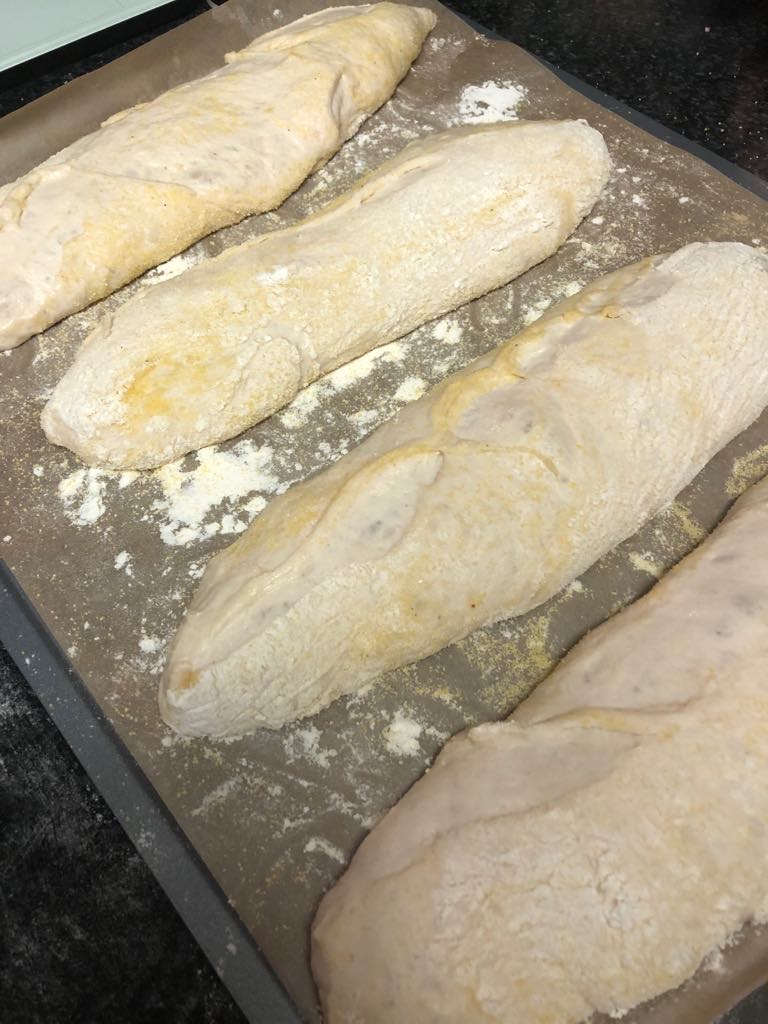
In the Masterclass, Mr. Hollywood perfectly demonstrates how to cut dough to maintain peak bubbliciousness. When your dough is blobbed out onto your flour and semolina, and you have a tray with parchment and semolina waiting, you simply cut your bread straight down with the dough cutter, then with your fingers, tip your bread onto the cutter with the cut side up and then in one swift motion stretch and place your bread on the tray. You want to have the cut part on top to give the bread its signature two lines on the top. That’s it, no shaping or smooshing necessary. I then rested my raw loaves for the prescribed twenty minutes, then threw my tray into the 450° oven for 26 minutes, and when I checked it had browned and looked an awful lot like ciabatta bread. I have to admit, I was totally surprised by that. I gave it a little knock-knock to see if it sounded hollow, and it indeed did.
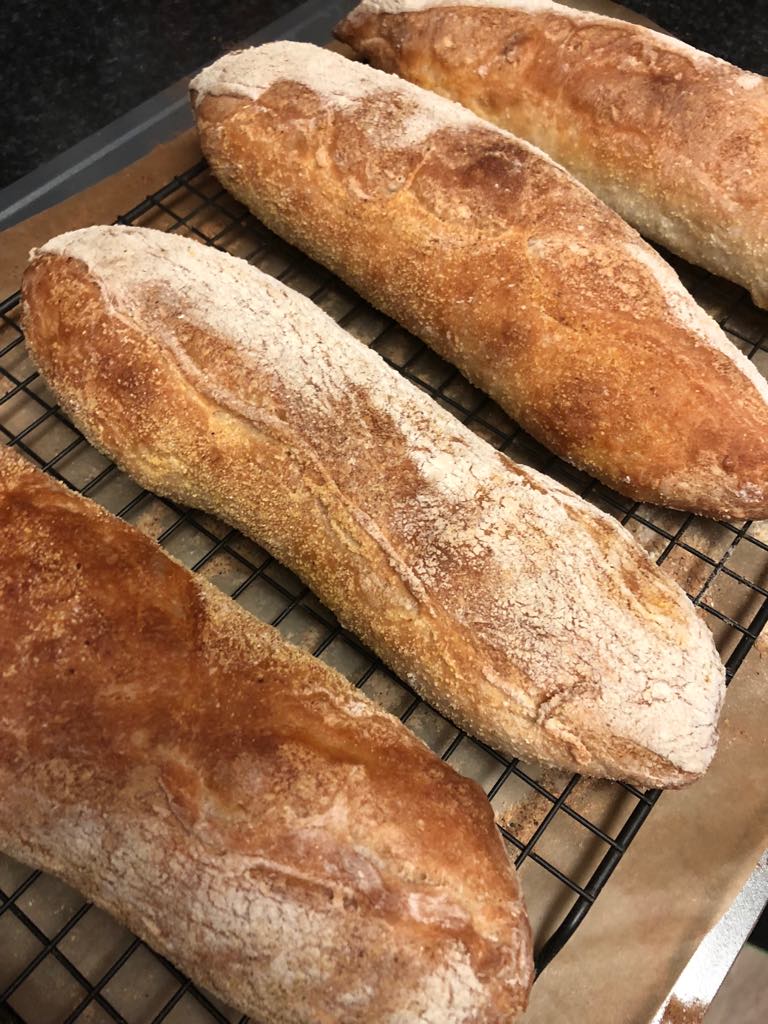
Did I make time? Third time must be a charm because for the first time I actually made the bake in the time allotted. In fact, I had time to spare! What is the sound of one hand high fiving? (Whoosh?)

The Gingham Altar
It is not enough that the ciabatta loaves are cooked and look like bread, they must be the bread that crushes and humiliates other bread. The bread has to be the platonic ideal of bread. And while I don’t have Paul “Voice of Bread” Hollywood and Mary “Ogler of Bread” Berry, I do have myself and my husband to judge this ciabatta against the criterion laid out by the man himself. I solemnly swear to judge myself harshly. I have plenty of practice at that.
Would it make the cut? Paul Hollywood sliced like a bread knife when it came to his anonymous judging of the humble ciabatta laid before him. He starts with Chetna’s on the end, “We’re actually looking for a ciabatta rather than a pita.” Daaaayum! That is some serious bread shade! It is rather Sherlock Holmes-ian the way Paul Hollywood can pick up an anonymous bread and accurately diagnose at a glance all of the pitfalls the baker made – “This one was forced in heat,” “This one has been handled,” “yeah, it’s olive oil,” and so on.
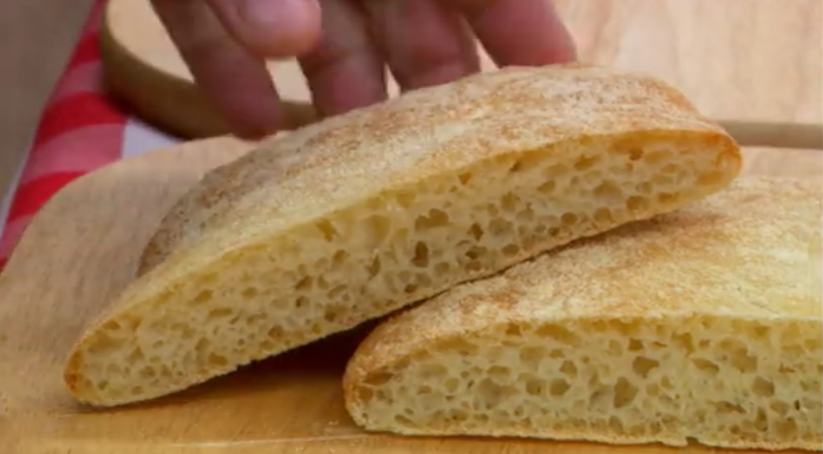
Hollywood made it clear that he was looking for a tall round loaf, with a floury, tough surface, and an irregular crumb structure with multi-sized bubbles on the inside. In last place was poor Jordan, who not only was the first to tip but also covered his ciabatta in oil rather than flour. Tsk tsk. In 9th and 8th was Iain and Chetna had both served up “pitas.” Martha, who was slightly under proved, was third, Luis was second, and Kate “Wood Nymph Gosling” with her nerves of steel was first. Not letting a person have a perfect loaf of bread, Hollywood mentioned that it may have been over handled, but it was the closest to a perfect ciabatta.
My ciabatta did have the signature roundness and when I cut into it I was relieved to see all of the beautiful bubbles that have been preserved in my bread. The flavor was delicious and the crust was chewy. I think the only downside is that maybe my ciabatta was a bit darker than golden. I might fall somewhere around Norman and Martha. They had very good bakes, but both of their breads were slightly under-proved. I dare say, my bread had the proper prove though it had a little extra color under that floury surface. I think I would put myself solidly in fourth.
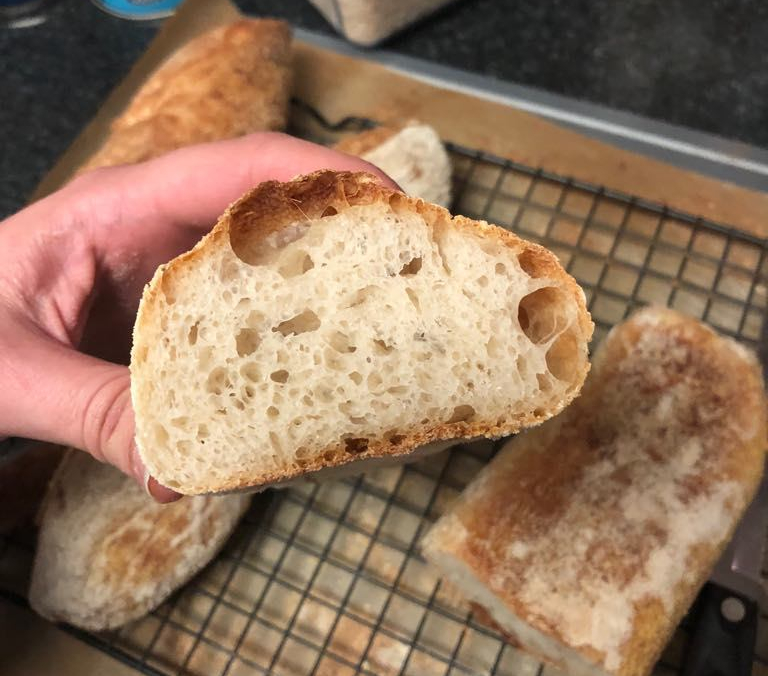
All-in-all, I think ciabatta is a pretty good beginner bread. It doesn’t take any special kneading skills or any fancy shaping. In fact, the number one thing to do with ciabatta bread is do nothing. And I love doing nothing. It’s one of my preferred things to do. Rufio! Rufio! RU-FI-OOOOOOO!
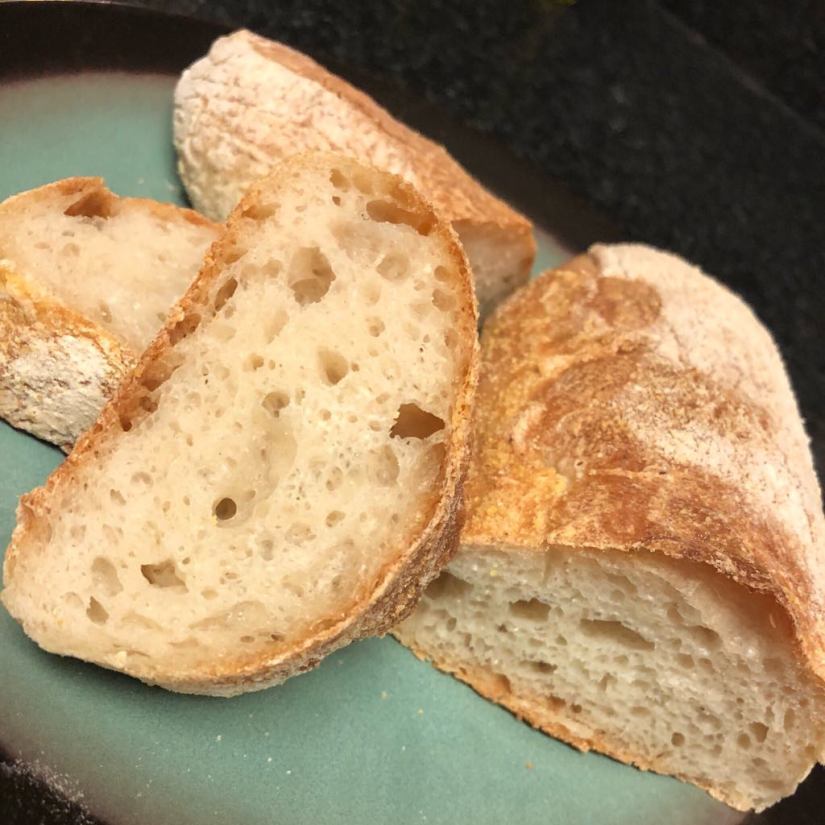
Recipe: Paul Hollywood’s Ciabatta
Ingredients
500 g of strong (bread) flour
10 g of fast action yeast
10 g of salt
440 ml of water
Olive Oil
Semolina flour
Directions
- Measure dry ingredients. In your mixer bowl, measure off your flour, yeast, and salt. Put your yeast on one side of the bowl and salt on the other.
- Add water. Add 3/4 of the water. Mix with the dough hook until a ball forms. Add a little more water at a time as you speed up the mixer until the dough starts slapping the bowl. The dough will be in the mixer for up to 15 minutes.
- Oil your box. Oil your 3 Litre square tub with olive oil, then move the dough to the container with your oily hands. Clip the lid and prove to the top at room temperature for 1-2 hours until your dough is up to the lid.
- Get everything set. Preheat the oven to 220° C Fan (420° F Fan/450° F conventional) and line your baking tray with parchment paper. Generously flour your bench with your bread flour and semolina.
- Cut your dough. Gently tip out your dough. Put semolina on top of your dough and on the tray. With your dough cutter, cut a quarter of your dough off firmly in a downward motion then tip and lift onto your tray so the cut stays on top. Use this method to create four loaves.
- Let it rest. Allow your dough to rest uncovered for 20 minutes.
- Bake it. Bake for 20-25 minutes (26-34 minutes conventional) until a crispy golden brown.





What a fun read! Loved it from beginning to end and also enjoy your photos and animations. Makes me so happy you got Kimberley and a great pic on the color I might add. Lisa, you are a wonderful writer. You should think about writing a book. And must not forget the recipe. You have inspired me to do a little baking when I get home. Come on over and let’s have a bread making session, you can point me in the right direction. The guys can talk or join in. It would be a blast!
LikeLiked by 1 person
Thanks so much, Denise! I think Kimberley and I will be very happy together. I would like love to make bread with you!!! Full disclosure, I tried to make the ciabatta again, and totally had a bread fail. I still had a fun time, though. ☺️
LikeLike